Learn how to make homemade sourdough puff pastry that can be used for anything from turnovers to pies. This easy recipes makes the most delicious, flaky, and buttery pastries.

This is the same dough I’ve used to make other pastries you can find here on the blog, but I wanted a place for just the puff pastry recipe.
A place to go when you find any recipe calling for store-bought puff pastry, but you want to make a healthier, fermented version from scratch.
So you can create family classics that a lot of us grew up eating (cough cough, pigs in a blanket), but with this homemade version instead. Grass-fed hot dogs wrapped in this classic puff pastry sounds pretty delicious if you ask me.
I love this recipe so much because it can be used in so many ways. From danish pastries to homemade pie crust, from sweet applications to savory fillings. It is an all around very versatile and a pretty easy recipe once you get the hang of it.

Tips
- Be careful to not let the dough or the butter get too warm during lamination. You want to work fairly quickly ensuring both stay around the same temperature. Rather than creating butter layers, the butter will just melt into the dough. If either the dough or the butter does get too warm, stick it in the fridge for 10-30 minutes and then continue working on the dough.
- This recipe uses natural yeast rather than commercial yeast to give rise to the dough.
- Make sure to check out how to make a sourdough starter here if you are just getting started with sourdough.
This post contains affiliate links, which means I make a small commission at no extra cost to you. See my full disclosure here.
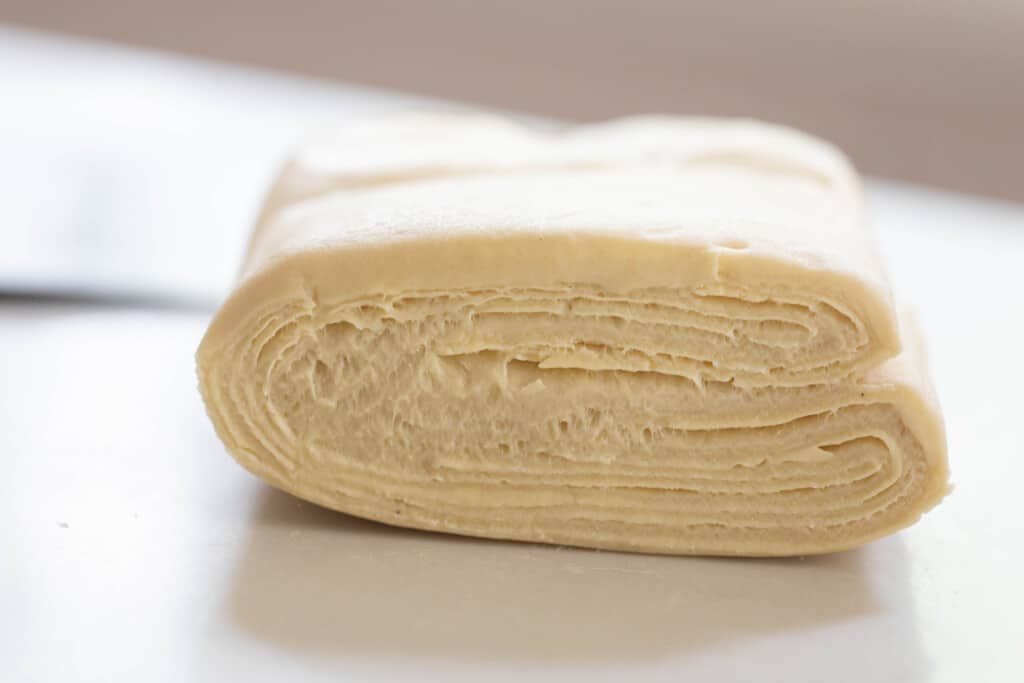
FAQ:
Some butter leakage during baking is normal. But if there is a lot of leaking something may have gone wrong during the lamination. The butter and dough may have gotten too soft making them combine together rather than creating flaking layers.
I recommend placing an empty baking sheet under the baking sheet with puff pastry during baking. This will catch any butter that leaks out and prevents it from hitting the bottom of the oven causing potential issues.
They are almost identical except that croissant dough is a bit drier, whereas pastry dough is more of an enriched dough (like brioche) that is moister and includes eggs.
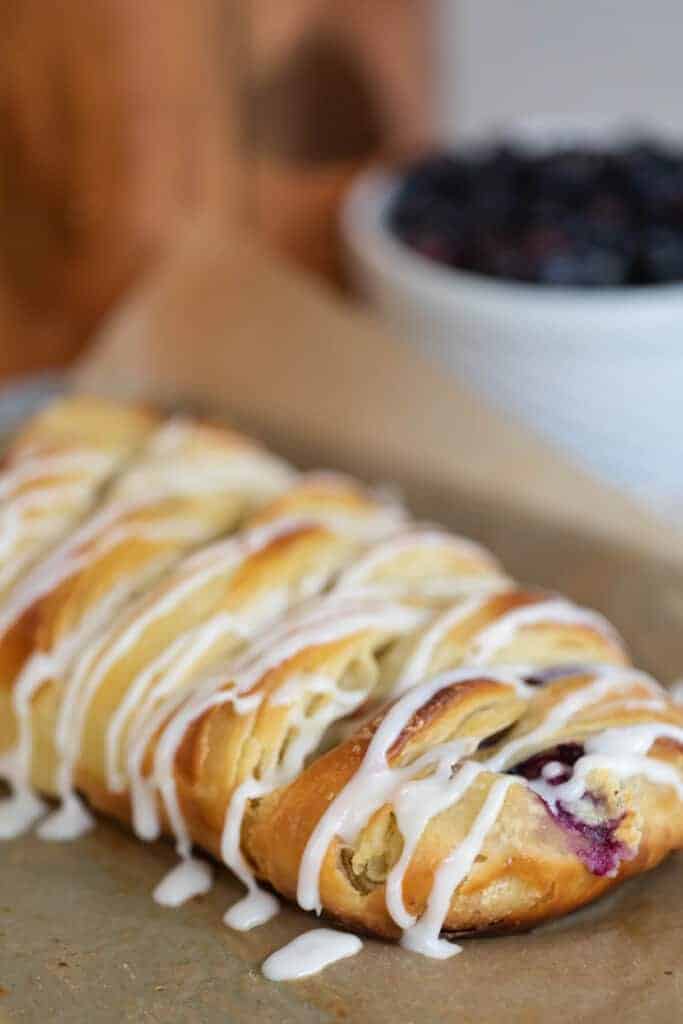
Dough Ingredients:
- All purpose flour
- Sugar
- Active sourdough starter, bubbly and active. You can not use sourdough starter discard for this, recipe unfortunately
- Whole milk
- Egg
- Vanilla extract
- Salt
Butter for laminating
- Unsalted butter: Cold. Make sure to use real butter. The fake stuff won’t work. The layers of butter will create the most flaky pastry.
- All purpose flour
Egg wash:
- Egg white
- Water

Filling ideas:
- Fruit: Fresh, canned or frozen fruit. If using canned fruit, make sure to drain any excess liquid. For frozen fruit, use from frozen, don’t let it thaw.
- Lemon curd
- Pie filling – This could be sweet pies like apple, cherry, blueberry etc. Or savory pies like chicken pot pie (swap out the biscuits), shepherd’s pie (add it to the top), quiche, etc.
- Jam
- Cream cheese
- Nutella
- Sausage
- Ground beef
- Chocolate
Tools you may need:
Stand mixer with dough hook attachment
Rolling Pin
Baking sheet – I like these stainless steel baking sheets
Parchment paper
Large mixing bowl
Bench scraper

How To Make Sourdough Pastry: Step-By-Step Instructions
To a bowl of a stand mixer with a dough hook attachment, add the dry ingredients, sourdough starter, milk, egg, and vanilla.
Mix on low speed (1 or 2) for about 5 or so minutes or until it becomes smooth and glossy. This ensures adequate gluten formation has occurred. You can also knead this by hand. Mix and knead to make a shaggy, sticky dough then continue to knead for about 5-10 minutes until smooth and glossy.
Shape into a ball and place in a greased large bowl. Cover with plastic wrap, foil, or a beeswax wrap and place at room temperature (a warm place) for about 4 hours.
Transfer the bowl to the refrigerator to continue fermenting for 8 hours, or up to 3 days.
Laminating the dough
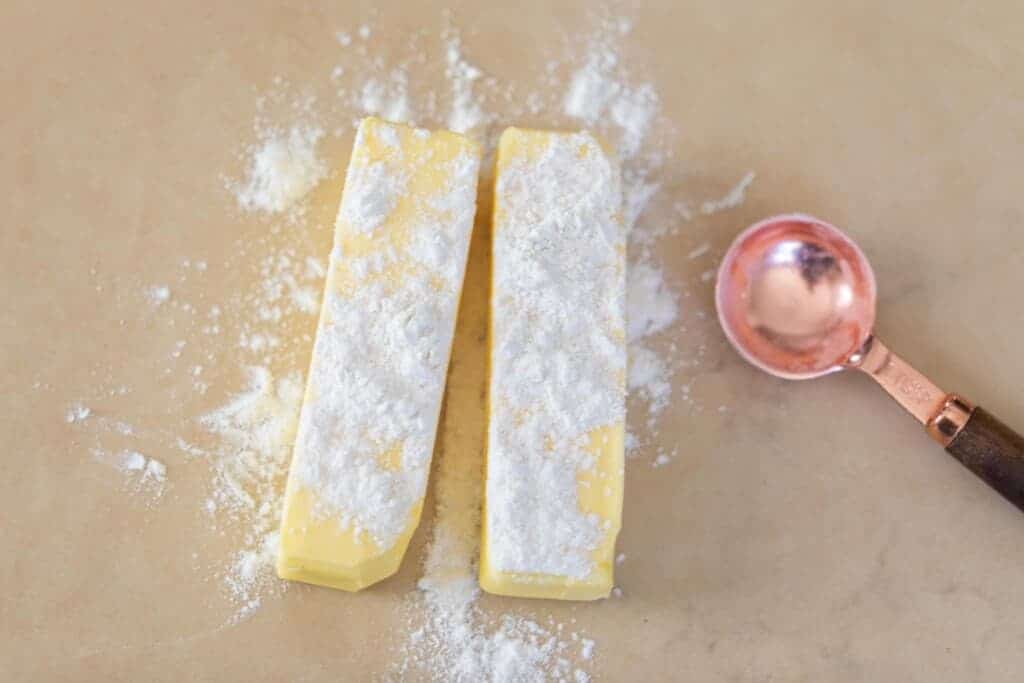
Place the sticks of butter on a large piece of parchment paper. Sprinkle it with a little flour. Mark a 6″ by 8″ rectangle onto the parchment paper.
Fold the parchment paper around the butter with the folds on that 6″ by 8″ rectangle you made, so that the butter will fill the entire envelope once you roll it out (also called a butter packet). It doesn’t need to be perfectly precise. You just want to make sure the pastry dough can enclose the butter when you roll it out for laminating.
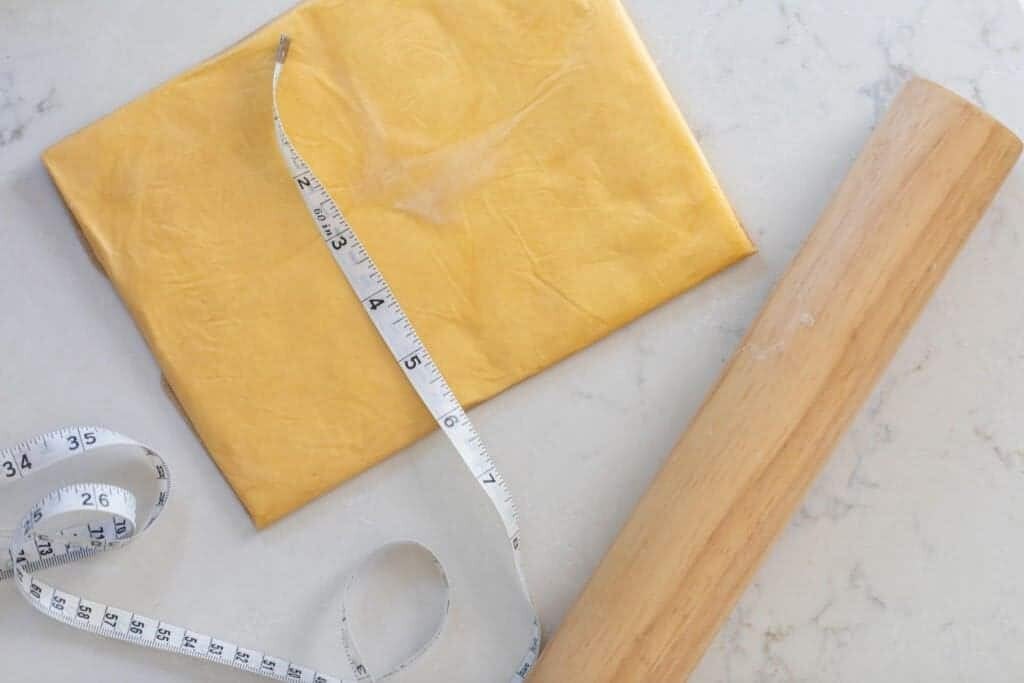
With a rolling pin, tap out the butter lightly to start to spread the butter, then roll smooth.
Chill the butter in the refrigerator for 10 minutes. You want the butter to stay nice and cold to create the layers of butter. If the butter gets too warm, it will just melt into the dough.
Remove the pastry dough from the refrigerator and place on a lightly floured surface.
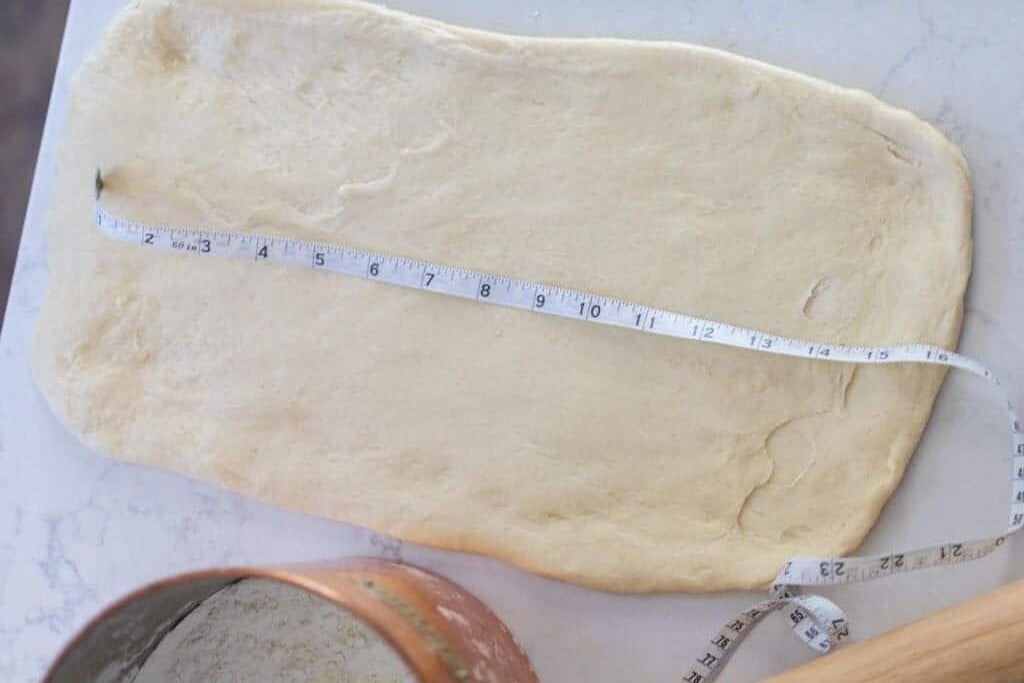
Roll it out into a 16″ by 8″ inch rectangle.
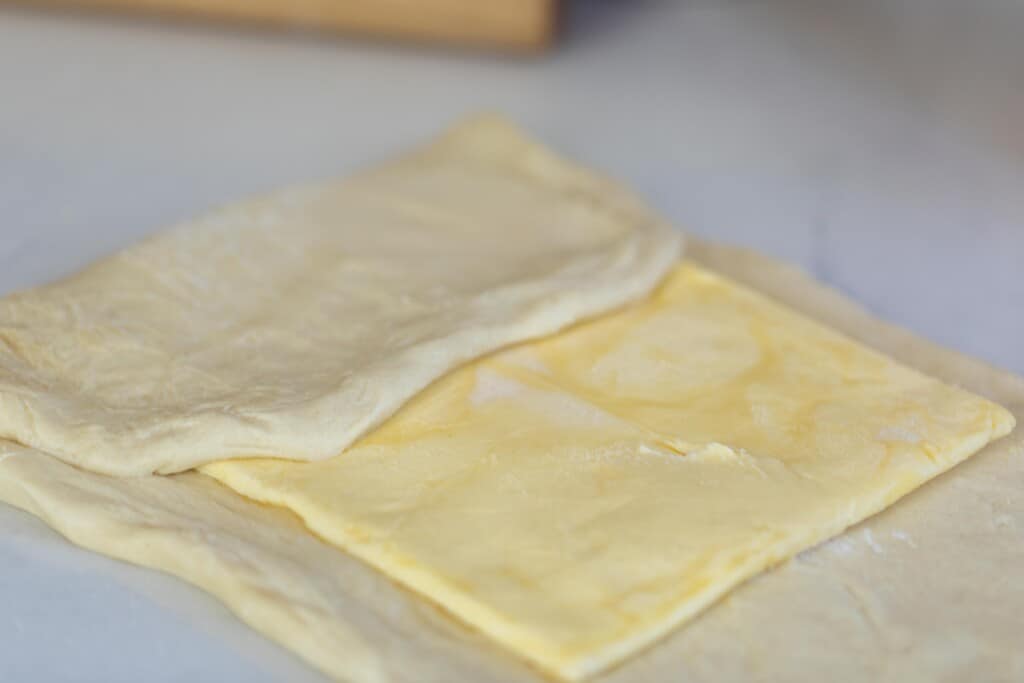
Place the butter rectangle in the middle of the dough. Fold the edges over, so they meet in the middle and completely encasing the butter. Pinch the dough together down the middle seam and sides closed, so none of the butter can escape.
First fold
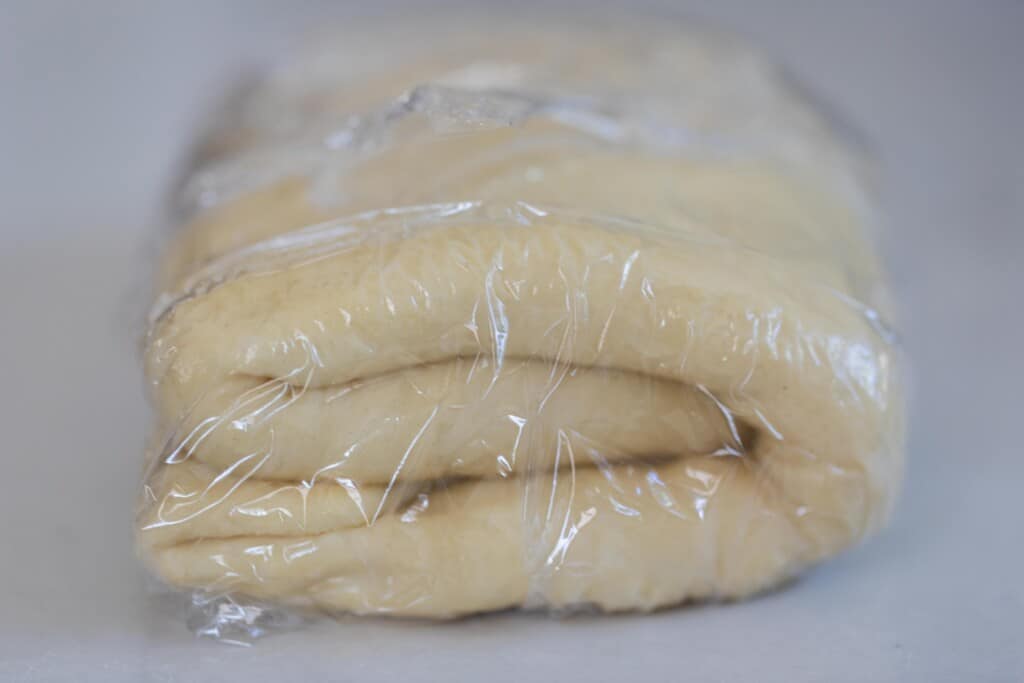
On a lightly floured work surface, roll the dough, with the butter sealed inside, into a 16″ by 8″ inch rectangle.
Fold each side into the center; then fold one side over the other to make a rectangle with four layers of folded dough. (See picture)
Wrap the dough in plastic wrap and place in the refrigerator for 30 minutes.
Second fold
Roll the dough out again into a 16″ by 8″ inch rectangle.
Fold each side into the center; then fold one side over the other to make a rectangle with 4 layers of dough.
Wrap the dough in plastic wrap and put it back in the refrigerator for 2 hours and up to 12 hours.
Use in any recipe calling for puff pastry.
What can you use sourdough puff pastry for?
- Turnovers
- Pop tarts
- Sweet pies – This makes a great sourdough pie crust recipe (although I have a recipe for that too. Find that here).
- Hand pies
- Savory pies like pot pies.
If you try this recipe and love it, I would love if you gave it 5 stars! Thank you! Tag me on Instagram @farmhouseonboone.
Sourdough Puff Pastry

Ingredients
Dough
- 3 cups all purpose flour, 420 grams
- 1/4 cup sugar, 50 grams
- 1/2 cup sourdough starter, bubbly and active (113 grams)
- 3/4 cup whole milk, 183 grams
- 1 large egg
- 1/2 teaspoon vanilla
- 1 teaspoon salt, 5 grams
Butter for laminating
- 16 tablespoons cold unsalted butter, 2 sticks or 227 grams
- 1 tablespoon all purpose flour, 9 grams
Egg wash:
- 1 large egg white, beaten lightly
- 1 tablespoon cold water
Instructions
- To a bowl of a stand mixer with a dough hook attachment, add the dry ingredients, sourdough starter, milk, egg, and vanilla.
- Mix on low speed (1 or 2) for about 5 or so minutes or until it becomes smooth and glossy. You can also knead this by hand. Mix and knead to make a shaggy, sticky dough then continue to knead for about 5-10 minutes until smooth and glossy.
- Shape into a ball and place in a greased large bowl. Cover with plastic wrap, foil, or a beeswax wrap and place at room temperature (a warm place) for about 4 hours.
- Transfer the bowl to the refrigerator to continue fermenting for 8 hours, or up to 3 days.
Laminating the dough
- Place the sticks of butter on a large piece of parchment paper. Sprinkle it with a little flour. Mark a 6″ by 8″ rectangle onto the parchment paper.
- Fold the parchment paper around the butter with the folds on that 6" by 8" rectangle you made, so that the butter will fill the entire envelope once you roll it out (also called a butter packet). It doesn’t need to be perfectly precise.
- With a rolling pin, tap out the butter lightly to start to spread the butter, then roll smooth.
- Chill the butter in the refrigerator for 10 minutes. You want the butter to stay nice and cold to create the layers of butter. If the butter gets too warm, it will just melt into the dough.
- Remove the pastry dough from the refrigerator and place on a lightly floured surface.
- Roll it out into a 16″ by 8″ inch rectangle.
- Place the butter rectangle in the middle of the dough. Fold the edges over, so they meet in the middle and completely encase the butter. Pinch the dough together down the middle seam and sides closed, so none of the butter can escape.
First fold
- On a lightly floured work surface, roll the dough, with the butter sealed inside, into a 16″ by 8″ inch rectangle.
- Fold each side into the center; then fold one side over the other to make a rectangle with four layers of folded dough.
- Wrap the dough in plastic wrap and place in the refrigerator for 30 minutes.
Second fold
- Roll the dough out again into a 16″ by 8″ inch rectangle.
- Fold each side into the center; then fold one side over the other to make a rectangle with 4 layers of dough.
- Wrap the dough in plastic wrap and put it back in the refrigerator for 2 hours or up to 12 hours.
- Use in any recipe calling for puff pastry.
Notes
- Be careful to not let the dough or the butter get too warm during lamination. You want to work fairly quickly ensuring both stay around the same temperature. Rather than creating butter layers, the butter will just melt into the dough. If either the dough or the butter does get too warm, stick it in the fridge for 10-30 minutes and then continue working on the dough.
- When baking puff pastry, place a baking sheet on a rack below the pan the pastry is baking. This is extra protection just in case butter leaked out during the baking proccess.
Nutrition
Nutrition information is automatically calculated, so should only be used as an approximation.















I made this recipe without the vanilla for a sausage roll recipe and it was SO good. The lamination on it was impressive!
Can this dough be stored in the freezer?
It would probably be better in the fridge.
This recipe looks very similar to the croissant recipe- can the puff pastry dough be used to make croissants?
Yes, you could!
Hi Lisa,
I am new to pastry and I would love to have a go. I am plant based, so I would like to ask you the egg with what could be replaced. Also the sugar would it be possible to be replaced by coconut sugar) I know that thhhe colour will change) or agave. Thank you,Arabela
The sugar can definitely be replaced with coconut sugar. I have not experimented with an egg replacement, but I would try whatever replacement you normally use and see how that works!
Hello, I’ve looked through many times but the baking temperature and time is missing in the recipe.
Hi there! This recipe just gives you an idea on how to make the puff pastry dough, to use in any recipe that calls for pastry. Here’s one of my favorite Danish pastry recipes.
I am new to sourdough and I think it would be great if you would make a video on how you make this puff pastry recipe. 😉
I show this in my video where I feature my Danish recipe! You can find it at this link at about the 19 minute mark: https://youtu.be/WCenQ313CC8?si=V0pUrtgi5mTOkBRa Hope that helps!
Hi! This looks amazing. I was wondering if you can use pastry flour in this instead of all purpose?
I’ve never used it, but I believe you can! Let us know how it turns out.
I tried it and it turned out great. It seems pastry flour has a higher protein content than all purpose, so it can absorb more liquid. The recipe turned out great and made delicious spinach artichoke puffs.
I tried it and it turned out great. It has a higher protein content than all purpose, so it can absorb more liquid. The recipe turned out great and made delicious spinach artichoke puffs.
Lisa, I see 2 puff pastry recipes. They look identical as far as ingredients but theother recipe says it makes 2 loaves, this one does not.
They are the same recipe, one was just made into a pastry braid where this one is just the puff pastry that can be used for pie crust, danishes, etc.
Hi Lisa! I’m new to sourdough but have been learning and this is the first time I’ve made this recipe of yours. I was wondering, in some puff pastry recipes they say to use one or two sheets of puff pastry, does this recipe make one sheet? Could I cut it and roll it out to be a bit thinner in order to make two sheets? Thank you!
You can cut it and roll it out to the thickness specified in any other recipe that calls for puff pastry!
Hi Lisa, I’ve made this recipe 3 times now. Results have been delicious every time. However I’m struggling with a lot of butter leakage during cooking. The last time I laminated the dough then waited two days before rolling it out to use. I make sure to keep dough and butter cold well making this. Just wondering if there is any other trouble shooting things I could try?
Some butter leakage is totally normal. I’ve never had it where it doesn’t happen slightly. My biggest tip is to make sure the dough and butter are the same temperature while you start the laminating process, and then keep the dough cold throughout the process.